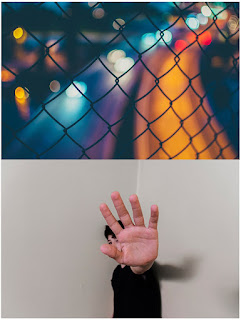Options are:
Opposites - two images of yourself that are completely opposite
Similar- Two images of yourself that are similar
Detail - A full body view of yourself & an image of yourself, but close-up.
09 January 2020
08 January 2020
FINAL: Self-Portrait Diptych - PRACTICE (20 points)
Diptych Practice (20 points)
The way the term is commonly used today, diptych simply means two images displayed together, usually side by side. The images often have something in common, like a general theme or shared subject, so that when viewed as a whole, they convey a larger message, narrative, or artistic statement.
DIRECTIONS.
1. Make a set of photographs of yourself
Options are:
Opposites - two images of yourself that are completely opposite
Similar- Two images of yourself that are similar
Detail - A full body view of yourself & an image of yourself, but close-up.
2. Develop TWO photos.
3. Assemble to a DIPTYCH
4. Post to your BLOG
5. Drop to the DRIVE.
The way the term is commonly used today, diptych simply means two images displayed together, usually side by side. The images often have something in common, like a general theme or shared subject, so that when viewed as a whole, they convey a larger message, narrative, or artistic statement.
DIRECTIONS.
1. Make a set of photographs of yourself
Options are:
Opposites - two images of yourself that are completely opposite
Similar- Two images of yourself that are similar
Detail - A full body view of yourself & an image of yourself, but close-up.
2. Develop TWO photos.
3. Assemble to a DIPTYCH
4. Post to your BLOG
5. Drop to the DRIVE.
06 January 2020
FINAL: SELF-PORTRAIT - Daydream/Nightmare
This project is about visual metaphor.
Visual metaphor is the representation of an idea through place/person/object/time/composition/color/etc.
RATIONALE:
To make images that are visual representations of what the two words - daydream & nightmare - mean to you, and to practice creative problem solving by thinking metaphorically and representationally.
DIRECTIONS:
1. Think of nightmare. What does that mean to you? What is the first picture that comes to mind? THAT could be your starting point.
2. What is the image you conjure when thinking of daydream? THAT could be your starting point.
3. With what you have access to in your personal life, how can you photograph THOSE ideas in way that will produce a well lit, purposefully composed images with visual metaphor?
***What place(s), objects, expressions, body language, light, etc. could you incorporate for each photo?***
THE PROCESS.
A. Make 3+ photographs that represent your definition of what a "daydream" looks like.
B. Make 3+ photographs that represent your definition of what a "nightmare" looks like.
C. Think outside the box to a sunny/pleasant place...and inside to a dark corner of the box.
D. You will be putting together a diptych next class. It will serve you to have THREE+ photographs of each idea to mix-and-match for the best possible combination to convey your narrative.
E. Test your creativity in new and challenging ways.
NOTE: You must be in one of the photos of the final diptych. No, do not make one of those ubiquitous selfies where you're trying to look good, but rather put yourself in the photo in some other way.
INSPIRATION:
Arthur Tress. CLICK HERE.
People lost in daydreams. CLICK HERE.
Visual metaphor is the representation of an idea through place/person/object/time/composition/color/etc.
RATIONALE:
To make images that are visual representations of what the two words - daydream & nightmare - mean to you, and to practice creative problem solving by thinking metaphorically and representationally.
DIRECTIONS:
1. Think of nightmare. What does that mean to you? What is the first picture that comes to mind? THAT could be your starting point.
2. What is the image you conjure when thinking of daydream? THAT could be your starting point.
3. With what you have access to in your personal life, how can you photograph THOSE ideas in way that will produce a well lit, purposefully composed images with visual metaphor?
***What place(s), objects, expressions, body language, light, etc. could you incorporate for each photo?***
THE PROCESS.
A. Make 3+ photographs that represent your definition of what a "daydream" looks like.
B. Make 3+ photographs that represent your definition of what a "nightmare" looks like.
C. Think outside the box to a sunny/pleasant place...and inside to a dark corner of the box.
D. You will be putting together a diptych next class. It will serve you to have THREE+ photographs of each idea to mix-and-match for the best possible combination to convey your narrative.
E. Test your creativity in new and challenging ways.
NOTE: You must be in one of the photos of the final diptych. No, do not make one of those ubiquitous selfies where you're trying to look good, but rather put yourself in the photo in some other way.
INSPIRATION:
Arthur Tress. CLICK HERE.
People lost in daydreams. CLICK HERE.
Subscribe to:
Comments (Atom)



